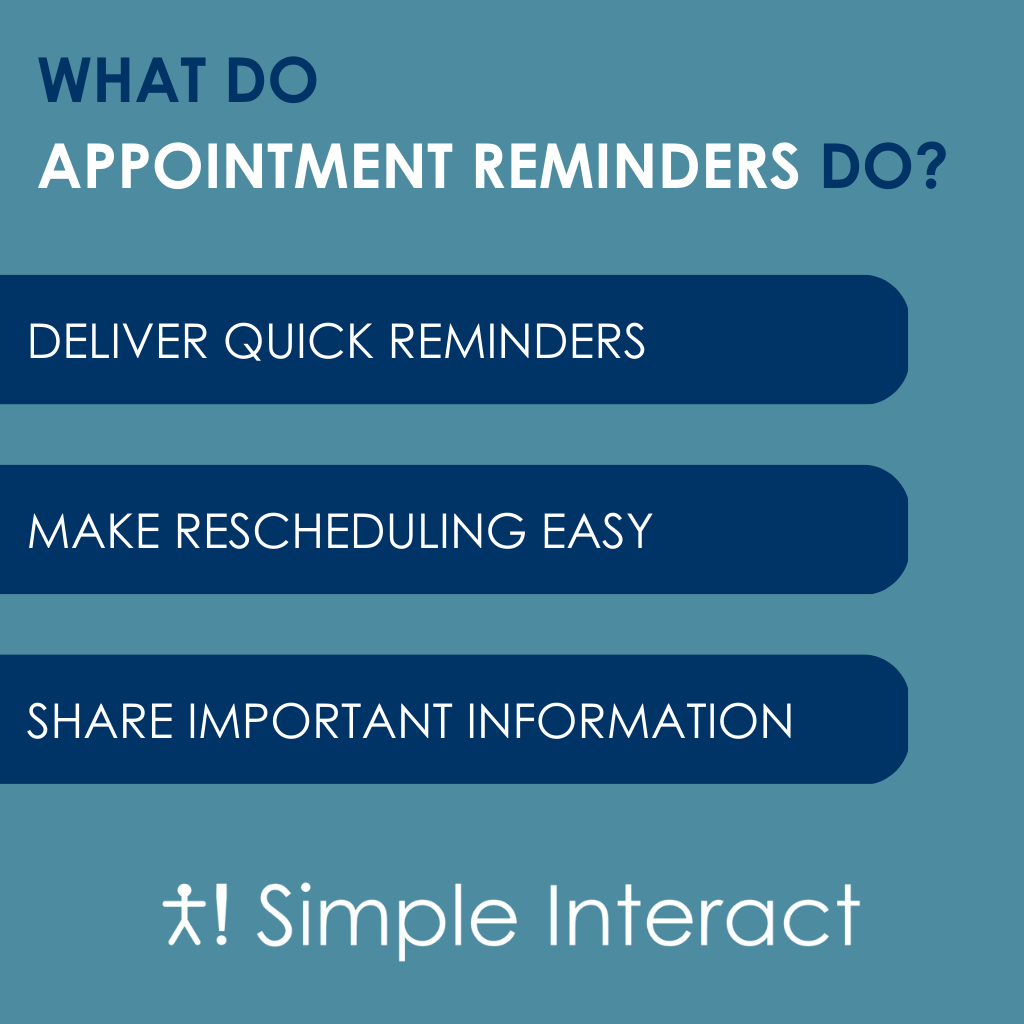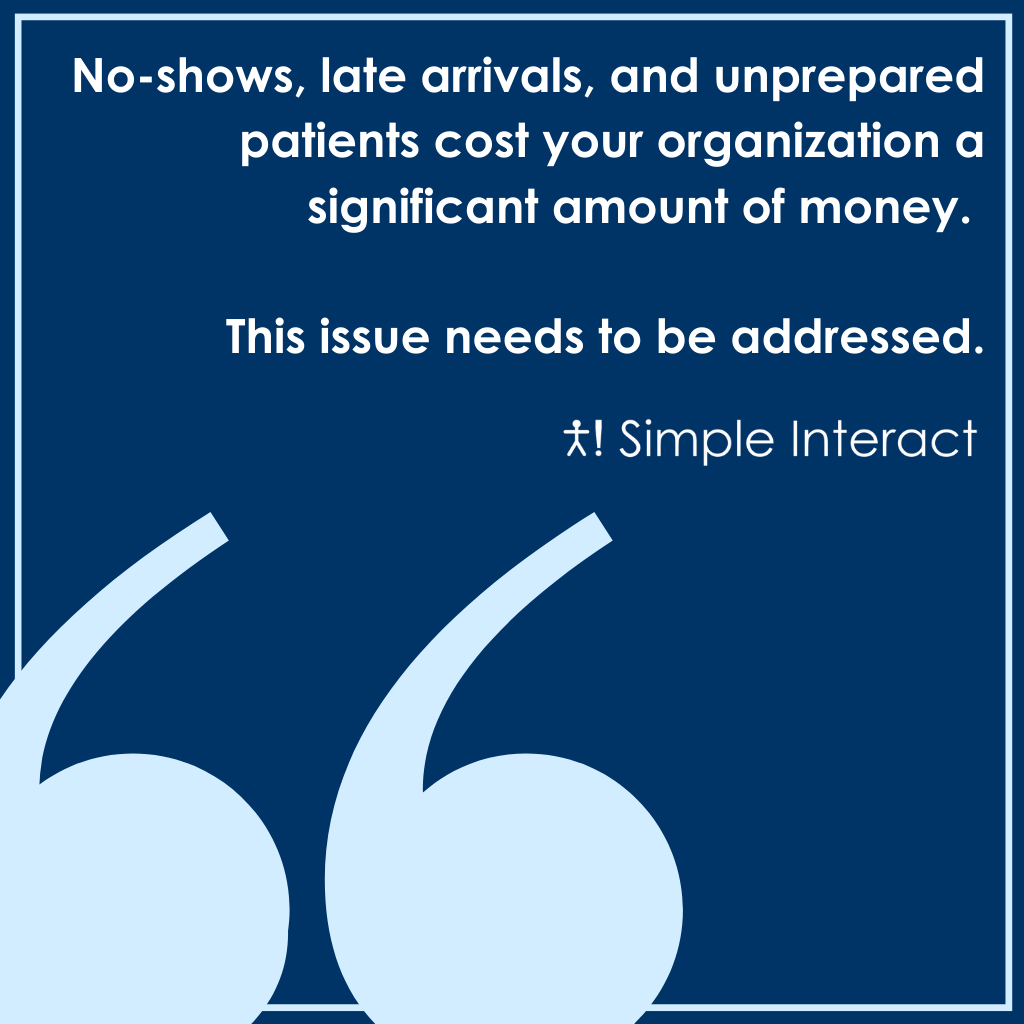Appointment Reminder Templates to Boost Patient Adherence and Reduce No-Shows

No-shows are a proverbial plague on healthcare facilities, reducing efficiency, frustrating staff, and resulting in significant lost revenue.
The percentage of no-show patients across healthcare organizations ranges from 3% (which is excellent) to 25% and upwards (which is terrible).
Patients fail to show up for many reasons, though some of the most common include patient scheduling conflicts, misunderstanding, or simply forgetting. Other times, patients will book with another healthcare provider without cancelling their existing appointment with you.
All these reasons are outside your control. But the final common reason for no-shows is something you have a say in: nonexistent or ineffective appointment reminders for patients.
Ensuring you have effective appointment reminder templates in place can make an enormous difference in your no-show rate. Appointment reminders effectively counteract many of the common causes of no-shows, such as forgetfulness, and can even help reduce late and unprepared arrivals.
Let’s examine how appointment reminders help prevent no-shows, discuss best practices for creating them, and look at an appointment reminder template (or two) you can use for your healthcare organization.
What Issues Do Missed Appointments Create for Your Practice?
No-shows cost the American healthcare system an estimated $150 billion a year. Individual physicians lose an average of $200 every time a patient fails to show up without notice.
On top of no-shows, you also have late arrivals, sometimes because a patient couldn’t find your office or showed up at the wrong location. These, along with unprepared and uninformed patients, cost your practice time, efficiency, and a good patient flow — and usually revenue as well.
It’s safe to say that no-shows, late arrivals, and unprepared patients cost your organization a significant amount of money. This issue needs to be addressed.
And, as we mentioned, effective patient reminder templates are a huge step in the right direction.

How Do Appointment Reminders Help Prevent Missed Appointments?
If you want them to work well, your appointment reminder templates need to perform three major jobs:
1. Deliver Quick Reminders
Your patients are busy with their jobs, families, and personal lives. A quick reminder about their appointment can make the difference between them showing up prepared and on time or not at all.
It’s especially important for messages to reach patients on the right device at the right time so the reminder actually makes a difference.
2. Make Rescheduling Easy
Having to cancel or reschedule appointments by phone is a barrier — which is why so many patients don’t do it. Maybe they can’t get through, or they get stuck on hold too long, so they hang up and don’t try again. Maybe they simply have trouble fitting a phone call into their busy day.
Whatever the reason, giving patients an easier option via an automated appointment reminder makes things extremely simple and convenient. They simply cancel their appointment or request to reschedule with the click of a button — no phone calls or wait times required.
3. Share Important Information
When patients fail to complete paperwork before their appointment, they cause delays in the waiting room and frustration for staff. And if they neglect pre-procedure protocol, it can mean their appointment or procedure has to be rescheduled — which has the same effect as a no-show.
When your appointment reminder templates share important information — like appointment location, time, forms to be completed, pre-procedure protocol — at the right times, patient adherence improves enormously and intake goes much more smoothly.
Best Practices for Appointment Reminders
Before implementing appointment reminder templates, take these best practices into account to ensure the best outcome.
Choose the Right Method of Communication
It’s important to reach people in the most effective way for them. Some patients may only have a landline, which means you’ll have to call them with a reminder. But most people own a cell phone, and most cell phones can receive SMS text messages.
Text messages and emails are non-intrusive, easy to view, and allow patients to complete the call to action at any time without greatly disrupting their day. Though we find that text messages have the highest response rate, that option won’t be right for everyone. It’s still important to offer email and voice options to make sure you reach your entire patient base effectively.
Request One Action at a Time
Each appointment reminder template should include only one “action item” at a time. Though it might not seem like much to include two or more small requests, it’s extremely easy to overwhelm the patient or give them too many tasks to complete in a few seconds. So they save them for later — and forget.
It’s much better to send several short reminders with one action item each than one long reminder with several steps, confirmations, etc.
For example, an appointment confirmation reminder can come first. Then you can send forms in a separate reminder. After those are completed, you can send pre-procedure instructions.
Select the Right Timing and Frequency
Most healthcare organizations will need to send at least three reminders to a patient, starting four to five days before the appointment. Here’s an example of a well-timed sequence for appointment reminder templates:
- 4–5 days prior: Ask the patient to confirm, cancel, or request to reschedule the appointment.
- 2–3 days prior: If you have not received confirmation, ask the patient to do so again.
- 1–3 days prior: Share forms or pre-procedure protocols (as needed).
- Day before or day of: Share the time, location, and any other important appointment details.
A note on location: It’s helpful to share the address of the appointment only in the final reminder message in case the appointment location changes for any reason. It also makes the address more easily accessible to the patient at the time they need to use it.
Automate Each Reminder
Ensuring your reminders are automated not only saves your office staff time, but it also ensures all reminders get sent out in a timely fashion, and none get forgotten through human error.

4 Appointment Reminder Template Examples
If you want to start sending appointment reminders but aren’t sure where to begin, we’ve provided several appointment reminder templates you can consider below. These are SMS text message templates, but they can be easily adapted for email or voice.
You’ll notice these templates maintain a consistent, direct voice throughout. Though you can find templates in a wide variety of voices online, remember to use the same voice in all your communications. We’ve found this format and voice are quite effective across the industry.
Template 1: Confirmation Request Form
Confirmation request from [HEALTHCARE ORGANIZATION NAME]:
Dear [PATIENT FIRST NAME], you are scheduled to see us on [DATE AND TIME]. Please click the following link to confirm that you will be here: [MINIFIED URL].
If you cannot keep this appointment, please click this link to cancel or request a reschedule: [MINIFIED URL].
Template 2: Final Confirmation Request Form
Final confirmation request from [HEALTHCARE ORGANIZATION NAME]:
Dear [PATIENT FIRST NAME], you are scheduled to see us on [DATE AND TIME]. Please click the following link to confirm that you will be here: [MINIFIED URL].
If you cannot keep this appointment, please click this link to cancel or request a reschedule: [MINIFIED URL].
Template 3: Pre-Procedure Instructions
Important pre-appointment instructions from [HEALTHCARE ORGANIZATION NAME]:
Dear [PATIENT FIRST NAME], to prepare for your upcoming [APPOINTMENT TYPE] appointment, please complete the following steps:
- [STEP 1]
- [STEP 2]
- [STEP 3]
If you have any questions, please give our office a call at [PHONE NUMBER].
Template 3B: Form Requirement
[HEALTHCARE ORGANIZATION NAME]: Dear [PATIENT FIRST NAME], a signed consent form is required before your upcoming telehealth appointment. Please use the link below to complete the Consent to Telehealth as soon as possible: [MINIFIED URL].
If you have technical difficulty, call us at [PHONE NUMBER]. On the day of your appointment on [DATE AND TIME], we will send you an email or text with a link to start your telehealth session. Be sure to start your session five minutes before your appointment.
Template 4: Same Day Reminder
Directions to your appointment today at [HEALTHCARE ORGANIZATION NAME]:
Dear [PATIENT FIRST NAME], you have an appointment scheduled at [TIME] in our [LOCATION NAME] location. Our address is [ADDRESS]. Please click this link to navigate [MINIFIED URL].
NOTE: Our main entrance is [SPECIFIC INSTRUCTIONS FOR ENTRY]. Click here to view the building entrance: [MINIFIED URL]. Please call us if you have any trouble getting to our location: [PHONE NUMBER].
Implement Your Appointment Reminder Templates
Missed appointments, late arrivals, and unprepared patients inflict huge losses on healthcare organizations. Why not curtail the problem by implementing a few great appointment reminder templates that will boost patient adherence and reduce no-shows?
If you’d like some help getting appointment reminder templates into place, we encourage you to reach out. We’d be delighted to explore how Simple Interact can help!

Ravi Kalidindi is the Founder and CEO of Simple Interact, a leading Front Office Automation company that helps healthcare facilities across the United States run more efficiently and profitably by boosting staff productivity, reducing provider burnout, and elevating the patient experience. Customers view Ravi as a trusted partner who can quickly comprehend business problems and suggest “keep it simple” solutions that are effective and easier to maintain over time.
Recent Posts
- The Benefits of Using 2-Way SMS Chat for Healthcare Communication
- 2-Way SMS vs. Live Chat: Which Is Best for Bi-Directional Patient Communication?
- Simple Interact Earns A+ Satisfaction Ratings in KLAS Report
- Boosting Healthcare Staff Productivity With a Shared Inbox Dashboard
- Healthcare SMS: What Metrics to Track in Your 2-Way SMS
Categories
Archives
- February 2025
- June 2024
- May 2024
- April 2024
- March 2024
- February 2024
- January 2024
- December 2023
- November 2023
- October 2023
- September 2023
- August 2023
- July 2023
- June 2023
- May 2023
- April 2023
- March 2023
- February 2023
- January 2023
- December 2022
- November 2022
- October 2022
- September 2022
- August 2022
- July 2021
- December 2020
- May 2020
- March 2020
- June 2016